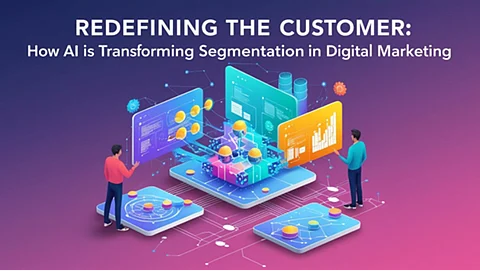

As the landscape of digital marketing continues to grow and transform, innovation is no longer an option. It’s imperative. One voice whose ideas impact mightily in this realm is Naveen Reddy Singi Reddy, whose scholarly expertise is reshaping what it means for marketers to communicate with consumers in the age of AI. His research reveals how artificial intelligence is reshaping customer segmentation, turning a once-static process into a dynamic and predictive strategy that prioritizes personalization, efficiency, and ethical data use.
The legacy segmentation models, which categorised customers according to rigid demographics such as age or gender, were previously the foundation of marketing campaigns. These approaches were inadequate at reaching the nuances of today’s consumer mindset. This transition to AI-backed behavioral segmentation marks an important upheaval going from strict categories to three-dimensional behavior profiling. By analyzing real-time data streams such as browsing habits, purchase history, and engagement metrics, AI enables brands to understand not just who a customer is, but what they’re likely to want next.
Perhaps the most significant of these innovations is the power of machine learning algorithms to learn independently, discovering patterns in human behavior, and adjusting their operations as new data becomes available. These systems proactively predict customer actions with striking precision. Through advanced clustering and predictive modeling, businesses can identify micro-segments, sometimes even down to the individual level, enabling more relevant communication and reducing the guesswork in campaign planning.
Deep learning pushes AI-driven segmentation even further by layering other data types texts, photos, videos on top the customer profiles. Based on a combination of digital and in-person interactions, this combination of channels uncovers subtle distinctions in consumer preference that the consumers might not even be consciously aware of. AI-enabled neural networks are able to measure aesthetic inclinations based on visual imagery, monitor mood stemming from feedback and communication outlets, and identify shifting pursuits via shopping history. The result is hyper-targeted marketing content that resonates deeply with recipients, enhancing engagement without feeling invasive.
From markets to social media, to search and advertising, in today’s fast-moving digital landscape, speed is everything. AI technologies today allow marketers to adjust the fly based on what consumers are doing as it is happening. These systems dynamically test, hone, and serve content permutations that most effectively resonate with the exact audience segments, sometimes even tailoring content to the time of day or mode of communication. Dynamic adaptation ensures that campaigns remain relevant even as external factors shift, from market trends to consumer mood, allowing for highly resilient and responsive marketing frameworks.
Predictive analytics takes AI-driven customer segmentation and engagement a step further by allowing businesses to engage with customers proactively. Whether it’s by predicting which customers are at risk of churn, which ones may be receptive to cross-sell offers, or estimating customer lifetime value, companies can better target their marketing efforts to improve both retention and revenue. Using these resource allocation models to prioritize budgets by move-impact produces an ecosystem in which marketing activities are driven by insight—not just data hindsight. This foresight empowers marketers to anticipate needs and deliver timely, relevant experiences that deepen customer loyalty.
As Spiderman’s Uncle Ben once said, With great power comes great responsibility. The use of generative AI in marketing presents significant ethical issues related to privacy, consent, and bias. The study points to the need for designing transparent, fair and auditable algorithms. It advocates for strong governance frameworks that prioritize consumer autonomy and data protection, ensuring that personalization efforts respect boundaries while still delivering value. Organizational readiness refers to the context and capacity within the applicant’s organization.
Deploying these high-tech systems isn’t just a technical challenge, it’s a cultural challenge. To get the most out of this opportunity, organizations need to evaluate their data infrastructure, train multidisciplinary teams to use it, and cultivate a culture that is receptive to data-driven decision-making. Skills development, change management, and robust data governance are critical components for success, enabling organizations to integrate AI tools without compromising operational coherence or ethical integrity.
As captivating as Naveen Reddy Singi Reddy’s work is in illustrating the future of digital marketing, AI that doesn’t simply automate segmentation but completely transforms it is still years away. By opening up granular behavioral insights and empowering organizations with real-time, predictive engagement capabilities, AI is paving the way for deeper, more meaningful customer interactions. As companies race to remain competitive in a world that’s becoming more and more customized, this new proven tactic will be essential for establishing trust, igniting growth, and creating long-term partners.
